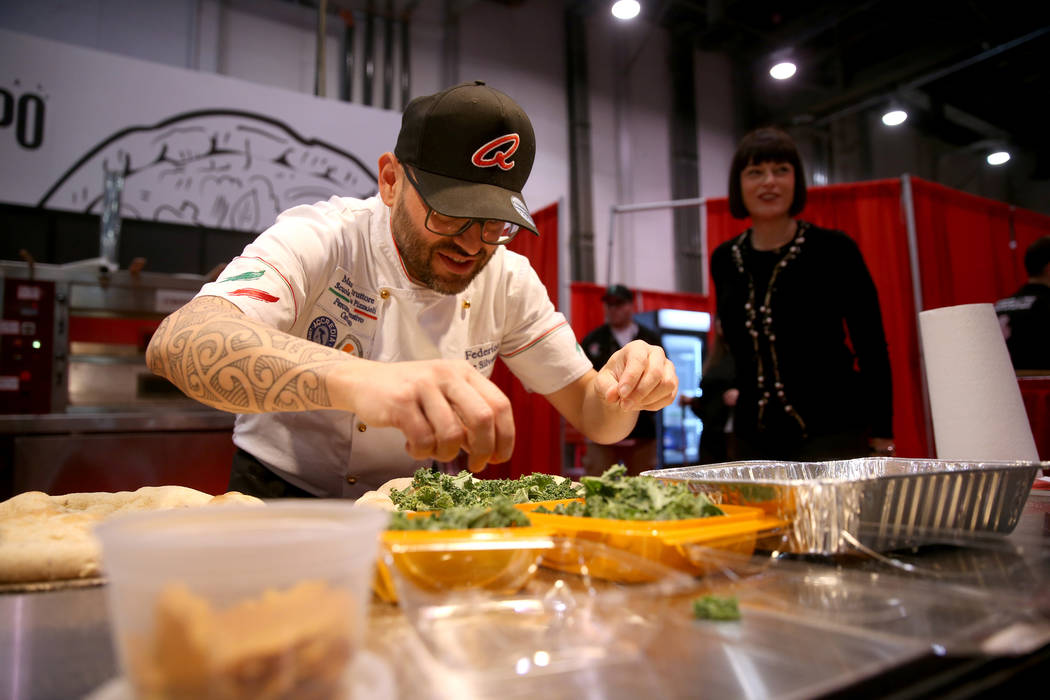The humble pizza pie has come a long way
Chris Bianco got started in the pizza business at a young age, like every other kid in his Bronx neighborhood.
“I never really thought of it as something I’d end up doing,” said Bianco, 56, who now has six restaurants and two collaborations, in the Phoenix area and Los Angeles.
The ingredients back then were pretty basic.
“The flour was very pedestrian — bromated or bleached,” he said. “Sauces came in cans. Cheeses were blocks that were just shredded in a very industrial manner. That’s just the way things were done.”
Bianco, who won the James Beard Award for Best Chef: Southwest in 2003, was the keynote speaker at last week’s International Pizza Expo at the Las Vegas Convention Center. At the Expo Italian national Federico De Silvestri won the World Pizza Champion title with a dough made with six flours, topping it with eggplant skin sauteed in oil with lime and salt, apple skin, toasted pistachios and radishes, among other things.
Pizza’s come a long way, and the famously modest Bianco had a lot to do with it.
“He really changed the face of our industry,” said John Arena, co-owner of the five Metro Pizza locations in the Las Vegas Valley. “He was one of the first people who thought about pizza as what it could be, not what it currently was in the United States. He was constantly experimenting, but also seeing a broader picture — not just wanting to re-create the pizza of Naples.”
And rather than buying his ingredients from Italy, Arena said Bianco chose to do what the Italians did, which was develop relationships with tomato growers, pig farmers and so on, to be part of the whole process.
“Chris always says he’s the last link in a very long chain, starting with the sunlight,” he said. “He sees himself as a steward of those amazing things that take place between when the seed was planted and the consumer takes a bite.”
“I just wanted to study and do the best that we could do,” said Bianco. “My whole life’s work to this day is a study of what makes things good — what makes a restaurant good, or a pizza, a hamburger, pasta, anything.”
As the American food scene went through a revolution, pizza followed along. Things were changing when he opened the first Pizzeria Bianco in 1988.
“There was definitely the beginning of the food revolution,” Bianco said. “Whether it was high-end or simple food, changes were starting to be made. Why shouldn’t pizza be a part of that? Why can’t it be something of the place and the season?”
“Now there’s a new generation of pizza makers who want to understand every part of the process, not just making pizza by rote,” Arena said. “They’re exploring and breaking down the components. It’s a simple food, but if we study every component of that food, we can turn it into something very special. So essentially, we’ve gone from being pizza assemblers to true pizzaoli. I think the most important thing is that people have decided to study the traditions and eventually transcend them and make it their own. They’re much more open to experimentation, taking things that are not necessarily common to the pizza world. A lot of pizza makers are talking about umami (a savory flavor profile), and where did that come from? That’s not an Italian word.”
Tony Gemignani, a 13-time World Pizza Champion, whose 22 restaurants include Pizza Rock in downtown Las Vegas and Little Tony’s at Palace Station, said social media also has contributed to the evolution of pizza.
“You’d always hear about maybe a Roman style and Neapolitan style, and unless you went to Naples and went to Expo, you wouldn’t be able to see it,” he said. “Now everything’s right in front of you.”
Gemignani said he can remember flying to Detroit to research its pizza.
“Now you can almost Google it,” he said with a laugh. “Which is good and bad.”
Ingredients previously unknown to a lot of Americans, such as sopressata and n’duja, have become popular pizza toppings. As for coming trends, he said Detroit-style is hot, as is Roman, “both on the board and in the pan.”
And he sees coming popularity for pinsa, a sort of subset of Roman, a little smaller and with a blend of multigrains.
Bianco sees more of the same in the future.
“We have a responsibility as the industry grows,” he said, “not to succumb to the way we used to do things, and continue to raise the bar. The possibilities are whatever we make them.”
Contact Heidi Knapp Rinella at Hrinella@reviewjournal.com or 702-383-0474. Follow @HKRinella on Twitter.






























